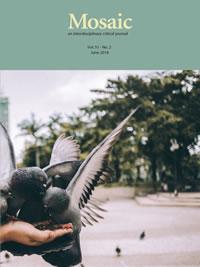Issue 51.2
Overview

General Issue
Published: June 2018
View the issue introduction or see the issue summary and contents below.
12 essays, totalling 216 pages
$24.95 CAD
With topics ranging from the origins of Romantic lyric, bibliotherapy, and the aging body in Marguerite Duras on to genre theory, the afflictions of Wallace Thurman, psychopomp in James Joyce, the manipulative gaze of war representation, and the ethics of film adaption, we encounter an acutely divergent set of topics. This “melancholy spectacle” of non-coherence—a description Paul de Man once used to characterize a collection of his own writings (viii)—demands thought.
Sing and Be Heard: Birdsong and the Romantic LyricOnno Oerlemans Looking particularly at John Keats’s “Ode to a Nightingale” and Samuel Taylor Coleridge’s “The Nightingale,” I argue that there are interesting connections between birdsong and poetry, similarities that poets themselves have recognized and attempted to articulate. Recognizing these connections helps us to see that poetry can bring us to a closer awareness of the complexity of animal being and that poetry, like birdsong, is a way of communicating back to the world. | |
Medicines of the Soul: Reparative Reading and the History of BibliotherapyJesse Miller This essay argues that despite its significance within the history of bibliotherapy, Samuel McChord Crothers’s 1916 essay “A Literary Clinic” is a stranger point of origin than proponents have realized—one with implications for conceptualizing reading and its reparative uses more broadly. | |
Latin American Abstraction: Upending Joaquín Torres-García’s Inverted MapAarnoud Rommens This essay nuances the legibility of Joaquín Torres-García’s Inverted Map of South America as the supposed symbol of Latin America’s cultural independence. Rather than a transparent “illustration,” I argue that the Inverted Map traces an ambiguous routing of mestizaje constantly disavowed in the artist’s discourse while animating his visual praxis. | |
Nomadic Genres: The Case of the Short Story CycleHager Ben Driss The short story cycle offers a pertinent example of a nomadic genre. Because it resists definition, it inhabits a liminal space straddling the short story and the novel. This essay focuses both on the agency of genre in shaping literary texts and on its capacity to be the receptacle of specific cultural and political concerns. | |
Linguistic and Libidinal Progressions in Sam Selvon’s The Lonely LondonersBiman Basu Sam Selvon’s The Lonely Londoners has drawn much critical attention for its language, its mix of Standard English and dialect. It has also drawn some criticism for its representation of sexuality. This essay draws attention to the text’s particular strategy for the emergence and clarification of meanings on both linguistic and libidinal registers. | |
Embodiment and Aging in Le ravissement de Lol V. SteinGina Stamm Through a reading of Marguerite Duras’s Le ravissement de Lol V. Stein, focusing on bodily sensation, this essay addresses the centrality of physically changing and aging bodies to the lives of the female characters. We can appreciate how Duras experimented through literature with different experiences of aging. | |
Wallace Thurman’s ‘Strange and Beautiful Human Pageant’: The Blacker the Berry and the Pageantry of DisabilityCorey Wozniak Recovering Wallace Thurman as a disabled author gives literary critics the advantage of fresh interpretive inroads to his creative work. In this essay, Thurman’s 1929 novel The Blacker the Berry is reread in light of his disability. The novel is found to celebrate bodily diversity and to challenge the ableism of certain of Thurman’s Harlem Renaissance contemporaries. | |
Vulva Zombies: Authorship in Erín Moure’s Pillage LaudDani Spinosa Erín Moure’s Pillage Laud is a transmedial text with an inhuman authorship (both human and machine) that reinterprets the cyborg as a zombie, where the binary of flesh and machine is collapsed. The result is a provocative feminist and erotic text that puts the onus of signification on the reader. | |
Sentimental Witnesses: Modern War Representation and the Eighteenth CenturyJohn Richardson Blood Swept Lands and Seas of Red, “Dulce et Decorum Est,” and The Things They Carried represent war through sentimental witnesses. The trend goes back to eighteenth-century sentiment and to writers of the American Revolution. This mode of war representation raises ethical and rhetorical concerns. | |
Lovers of America (the USA): Mira Nair, The Reluctant Fundamentalist, and the Politics of AdaptationAlbert Braz While most critics dismiss the notion of fidelity in adaptations, they often resist jettisoning the idea that an adaptation must be directly linked to its source text. Mira Nair’s film The Reluctant Fundamentalist illustrates the reasons for this paradoxical response, since it subverts the politics of its ostensible model. | |
The Dynamics of ReadingNicolae Babuts The essay offers a cognitive view of literature. It adduces neuroscientific evidence indicating the role of memory in literary creations and reading. It gives examples of critical readings that represent different approaches to literary texts. | |
From Bird Girls to Bat Souls: Joycean Transformations of a Homeric TropeMichael Gleason and Anne C. MacMaster We read a funny episode in James Joyce’s Ulysses as a valuable reworking of a motif from his earlier Portrait. In “Nausicaa”’s parody, Stephen Dedalus’s bird girl has become Leopold Bloom’s bat-girl, and Homer’s little black trope returns in multiple roles as awakening soul, priestly vampire, and sexual liaison. |